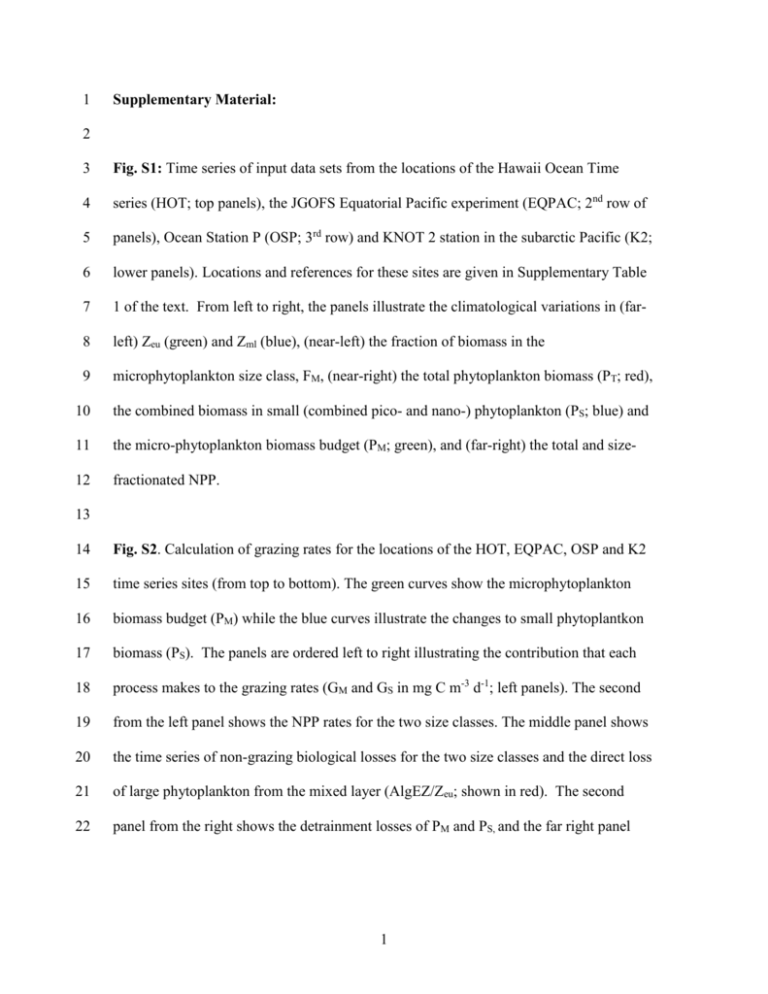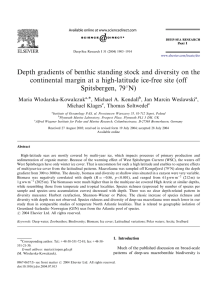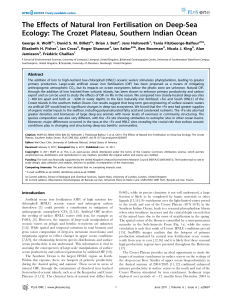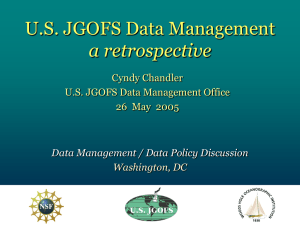SuppReadme_Jan15_2014
advertisement

1 Supplementary Material: 2 3 Fig. S1: Time series of input data sets from the locations of the Hawaii Ocean Time 4 series (HOT; top panels), the JGOFS Equatorial Pacific experiment (EQPAC; 2nd row of 5 panels), Ocean Station P (OSP; 3rd row) and KNOT 2 station in the subarctic Pacific (K2; 6 lower panels). Locations and references for these sites are given in Supplementary Table 7 1 of the text. From left to right, the panels illustrate the climatological variations in (far- 8 left) Zeu (green) and Zml (blue), (near-left) the fraction of biomass in the 9 microphytoplankton size class, FM, (near-right) the total phytoplankton biomass (PT; red), 10 the combined biomass in small (combined pico- and nano-) phytoplankton (PS; blue) and 11 the micro-phytoplankton biomass budget (PM; green), and (far-right) the total and size- 12 fractionated NPP. 13 14 Fig. S2. Calculation of grazing rates for the locations of the HOT, EQPAC, OSP and K2 15 time series sites (from top to bottom). The green curves show the microphytoplankton 16 biomass budget (PM) while the blue curves illustrate the changes to small phytoplantkon 17 biomass (PS). The panels are ordered left to right illustrating the contribution that each 18 process makes to the grazing rates (GM and GS in mg C m-3 d-1; left panels). The second 19 from the left panel shows the NPP rates for the two size classes. The middle panel shows 20 the time series of non-grazing biological losses for the two size classes and the direct loss 21 of large phytoplankton from the mixed layer (AlgEZ/Zeu; shown in red). The second 22 panel from the right shows the detrainment losses of PM and PS, and the far right panel 1 1 shows the time rate of change of PM and PS. Note the change of vertical scales in the 2 different panels and the general decrease in rates (all in mg C m-3 d-1) from left to right. 3 4 Fig. S3. Time series of TotEZ (red), FecEZ (green) and AlgEZ(blue) fluxes (in mg C m-2 5 d-1) for the locations of the HOT, EQPAC, OSP and K2 time series sites. 6 7 Fig. S4: Temporal changes in the global monthly anomalies for a) <TotEZ’> and b) <EZ- 8 ratio’>, c) the contribution of each zone of latitude to <TotEZ’> and d) the contribution 9 of each zone of latitude to <EZ-ratio’> calculated using the monthly climatology for FM. 10 Only data equatorward of 50o latitude are used. 11 12 2 1 Supplementary Table 1: Locations of the selected time series sites Abbreviation Full Name BATS Bermuda Atlantic Time series Site North Atlantic Bloom Experiment Station ALOHA NABE ALOHA EQPAC OSP K2 Nominal Location 32oN 64oW Citation 47oN 20oW Buesseler et al. [1992]; Lampitt et al. [2008] Karl et al. [1996]; Buesseler et al. [2008] Bacon et al. [1996] 23oN 158oW 0oN 140oW JGOFS Equatorial Pacific Experiment Ocean Station P KNOT 2 50oN 145oW 47oN 160oE Steinberg et al. [2001] Charette et al. [1999] Honda et al. [2006]; Buesseler et al. [2008] 2 3 4 References for Supplementary Table 1: 5 6 Bacon, M.P., J.K. Cochran, D. Hirschberg, T.R. Hammar, and A.P. Fleer, (1996), Export 7 flux of carbon at the equator during the EqPac time-series cruises estimated from 234Th 8 measurements. Deep-Sea Research II, 43: 1133-1154. 9 10 Buesseler, K.O., M.P. Bacon, J.K. Cochran, H.D. Livingston, (1992) Carbon and nitrogen 11 export during the JGOFS North Atlantic Bloom Experiment estimated from 234Th: 238U 12 disequilibria. Deep-Sea Res. I 39: 1115-1137. 13 14 Buesseler, K.O., T.W. Trull, D.K. Steinberg, M.W. Silver, D.A. Siegel, S.-I. Saitoh, C.H. 15 Lamborg, P.J. Lam, D.M. Karl, N.Z. Jiao, M.C. Honda, M. Elskens, F. Dehairs, S.L. 16 Brown, P.W. Boyd, J.K.B. Bishop, R.R. Bidigare (2008), VERTIGO (VERtical 3 1 Transport In The Global Ocean): A study of particle sources and flux attenuation in the 2 North Pacific. Deep-Sea Research Part II, 55, 1522-1539. 3 4 Charette, M.A., S.B. Moran, and J.K.B. Bishop, (1999), 234Th as a tracer of particulate 5 organic carbon export in the subarctic Northeast Pacific Ocean. Deep-Sea Res. II 46, 6 2833-2861. 7 8 Karl, D.M., R. Lukas, (1996), The Hawaii Ocean Time-series (HOT) Program: 9 Background, rationale and field implementation. Deep-Sea Res. II 43,129–156. 10 11 Honda, M.C., H. Kawakami, K. Sasaoka, S. Watanabe, and T. Dickey, (2006) Quick 12 transport of primary produced organic carbon to the ocean interior, Geophys. Res. Lett., 13 33, L166603, doi: 10.1029/2006GL026466. 14 15 Lampitt, R.S., B. Boorman, L. Browna, M. Lucas, I. Salter, R. Sanders, K. Saw, S. 16 Seeyave, S.J. Thomalla, R. Turnewitsch, (2008) Particle export from the euphotic zone: 17 Estimates using a novel drifting sediment trap, 234Th and new production. Deep-Sea 18 Research I, 55, 1484–1502. 19 20 Steinberg, D.K., Carlson, C.A., Bates, N.R., Johnson, R.J., Michaels, A.F., Knap, A.H., 21 (2001) Overview of the US JGOFS Bermuda Atlantic Time-series Study (BATS): a 22 decade-scale look at ocean biology and biogeochemistry. Deep-Sea Research II 48, 23 1405–1447. 4










